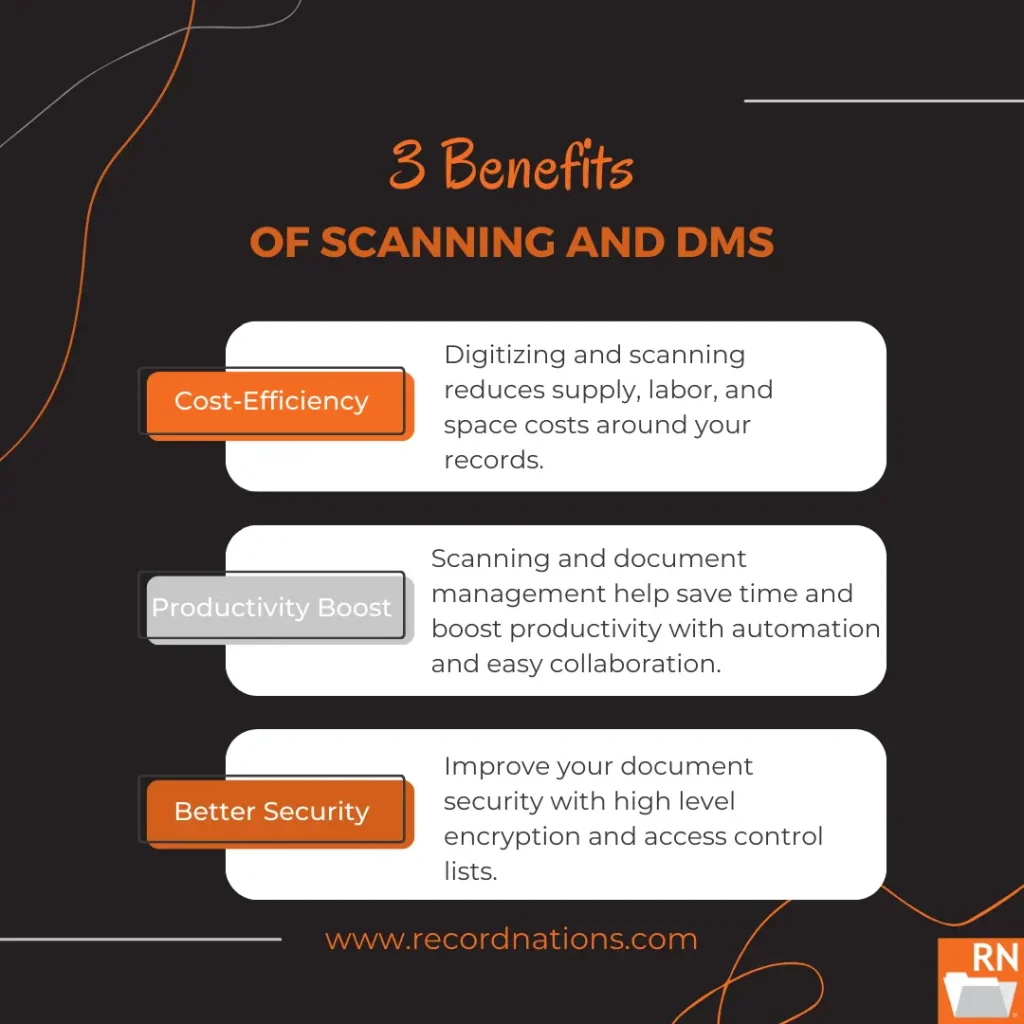
In addition to cleaning up the workplace there are numerous other reasons and benefits from implementing document scanning when you’re working to declutter paper.
For example, while reorganizing paper files works as a temporary solution for improving workflow, scanning the records and converting them to digital format provides a permanent answer for how to keep the workplace free from clutter.
In this video learn more about the specific reasons and benefits of scanning while decluttering ranging from lower records management costs to improved records security and productivity.
Why Use Scanning to Declutter Paper
Besides just tidiness, there are multiple reasons to use scanning with a New Year’s resolution to declutter.
Among others, some of the top reasons include:
- Lower costs
- Higher productivity
- Improved security
- Simplified retention tracking
Document Scanning Cuts Records Management Costs
According to the IDC, businesses spend over $2.5 million on time wasted searching for lost files.
While a decluttering and reorganizing project for your paper helps to save time and boost productivity immediately after, searching and refiling papers still takes time and eventually the clutter will build back up, meaning you’ll still end up wasting time over the course of the year—just not as much.
By using scanning to clean up files though, it provides a solution for both problems. Not only will converting to digital clear out paper clutter permanently, it will also boost productivity with the ability for users to quickly find and use the new files in an electronic document management system (DMS).
Improve Security Protections While You Scan
Using scanning to convert files as you declutter helps to protect from identity theft and other security risks in three ways:
- By scanning documents and implementing them with DMS systems after you’re able to remove potentially sensitive information from the workplace entirely—leaving nothing for thieves to steal.
- While a locked filing cabinet in the office is still at risk of fire damage, DMS systems use multiple layers of security tools ranging from regular data backups to encryption and access controls.
- Scanning and converting files to digital format means you can shred all the old paper copies afterwards without worrying about what you need to keep—also helping to not just reorganize things but clear out the workspace altogether.
How Scanning Simplifies Retention Tracking
Numerous documents regulated by legal record retention periods are being reorganized during a decluttering project, and while tracking records will be easy immediately after cleaning things up, over time the paper clutter—and the chances of missing a retention time—will start to build up again.
By implementing scanning and conversion with decluttering on the other hand the new DMS system can be configured to automate retention tracking, helping to simplify record retention both now and in the future.
Post Scanning and Paper Declutter Benefits
Besides during the actual decluttering and cleaning, using a DMS to manage new digital records also helps going forward with advantages ranging from boosted security to improved time and cost-efficiency.
Boosting Cost-Efficiency
Electronic records management helps to save money is three main ways:
Supply Costs
By removing paper from the workplace entirely you in turn save on the cost of supplies and resources needed for managing hard-copy records, such as paper, printer ink and toner, and file cabinets or shelving for storage.
Labor Costs
A DMS system allows users to search for files by keyword and quickly access, copy, or distribute needed files, as a result improving employee productivity and getting you more for your money.
Space Costs
Besides organizing workflow and reducing resource costs, thousands of scanned files can be stored digitally in a fraction of the space needed for paper storage—opening up the opportunity to use the space more efficiently or cut back on real estate costs.
Improving Productivity
Scanning and implementing a DMS also helps productivity and time-efficiency in several ways.
For example automated tracking systems can be configured to help streamline administrative work like managing record retention.
Another benefit is the ease of use. Quickly accessing, copying or distributing files can all be done within the system and doesn’t require any other equipment, helping to prevent multiple copy errors and maintain future organization.
Finally, the extra space created from cleaning out paper and scanning the files can instead be used for extra employees, customer areas, or other revenue-generating alternatives.
Upgrading Security
DMS systems use multiple methods for protecting sensitive PII from both internal and external security risks:
Document Encryption
To protect from external threats DMS systems use document encryption to make files jumbled and indecipherable. That way, even if sensitive information is stolen, it will be useless to thieves without the decryption key.
Access Control Lists (ACL)
For internal risks password-based access controls can be configured to control and limit which users can access files, helping to keep critical information in the hands of only those who need it. For sensitive information ACLs with multiple tiers can be implemented to reinforce protection.
Trying to Declutter Paper in Your Workspace?
Record Nations can help. We provide secure and affordable scanning, document management, and records storage services across the country. To get started on finding a solution that works for you, give us a call at (866) 385-3706, or fill out the form on the page, and we’ll connect you to a partner that fits your needs within minutes.















